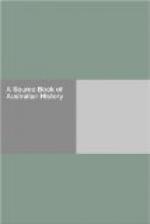Having pursued exactly the same course and acted on exactly the same principles with my predecessor, I am confident that I shall receive similar personal support. Moreover, I submit that it is of supreme importance, on public grounds, that the people of the Australasian Colonies should know that the actions and conduct of successive Governors are not prompted by the personal views or idiosyncrasies of individuals, but that they are guided by a consistent and uniform policy, sanctioned by the authority of the Imperial Government.
NEW GUINEA
+Source.+—New Guinea. By Charles Lyne (special representative of the “Sydney Morning Herald"), pp. 1-28
In 1882, the Queensland Government took alarm at certain rumours of the intention of Germany to annex New Guinea, but for a time the British Government refused to move. When the establishment of a protectorate was authorized, only the southeastern portion of the island was available, Germany having, in the meantime, annexed the northern part and the group of Islands known as New Britain.
Commodore Erskine in H.M.S. Nelson arrived at Port Moresby on Sunday, the 2nd of November, 1884, and the Union Jack now flies from the flagstaff at the mission station, the Proclamation of a British Protectorate having been made with much ceremony on Thursday Nov. 6.
On the Wednesday afternoon, the chiefs and a number of other natives were brought on board the H.M.S. Nelson, and a grand assembly took place, with a feast for the chiefs and an address from the Commodore, a presentation of gifts attractive to the native eye, and the firing of some of the ships’ guns. The flags of various nations were hung over the quarter-deck in the form of an awning, and the officers wore frock-coats and swords. Most of the chiefs were destitute of clothing, the mop-like hair and foreheads of some of them being bound round with bands of small shells and the hair ornamented with tufts of feathers. Two or three wore old shirts, and one, Boe Vagi, the chief of the Port Moresby natives, who was appointed by the Commodore to be the head chief of the Motu tribe, was dressed in a shirt, with a handkerchief round his loins, a red felt hat on his head, and some green leaves through the lobe of his left ear. Evidently he had been attired specially for the occasion, as his usual dress is as scanty as that of his fellows. There were in all about fifty of the chiefs, most of them being representatives of the Motu tribe; and after having been permitted to look round the ship, they were directed by the missionaries, Messrs. Lawes and Chalmers, to seat themselves upon the deck. Then a great tub of boiled rice, sweetened with brown sugar, was brought on deck, and basins of this mixture were handed round to the chiefs who received them, and devoured the rice with evident satisfaction. Ships’ biscuits were also served out, and the scene presented by the feasting savages, and by the grouping of the Nelson’s officers and the parading of the bluejackets on the opposite side of the deck—so that a photograph might be taken of the whole assembly—was exceedingly interesting and picturesque.




